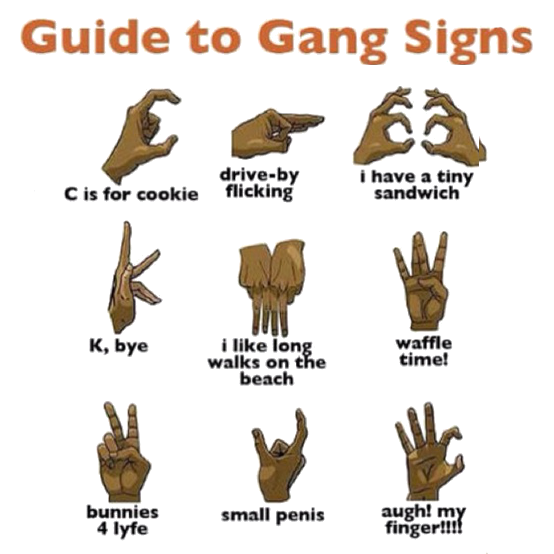Gang signs have long been a part of urban culture, often misunderstood and misrepresented in mainstream media. They are more than just hand gestures; they represent a complex language of identity, loyalty, and territory within various communities. Understanding the meanings behind these signs is crucial for grasping the dynamics of gang culture, as well as the socio-economic factors that contribute to its existence. In this article, we will explore the various aspects of gang signs, their meanings, and the implications of their use in society.
To truly understand gang signs meaning, one must consider the historical context in which they evolved. Many gangs originated as a response to social injustices, economic disparities, and a lack of support within their communities. Over time, the use of signs has become a means of communication, a way to assert dominance, and a method of identifying allies and adversaries. This article aims to shed light on the complexities surrounding gang signs and provide insight into their significance.
Moreover, the portrayal of gang signs in movies and television often skews public perception, leading to misconceptions about their purpose and the individuals who use them. As we dive deeper into this topic, we will address common questions and concerns, debunk myths, and highlight the realities of gang life. Join us as we unravel the meaning behind these often-misunderstood symbols and gestures.
What Are Gang Signs?
Gang signs are hand gestures that convey messages among gang members. They can signal various meanings, including identification, allegiance, and even threats. The use of these signs often varies from one gang to another, and their meanings can differ based on context and location. Here are some key points about gang signs:
- They can be specific to certain gangs or regions.
- Some signs are universally recognized within the gang culture.
- They can be a way to communicate without using words, especially in situations where speaking may not be safe.
Why Do Gangs Use Signs?
Gangs use signs for a variety of reasons, including:
- Identification: Signs help gang members identify each other, especially in hostile environments.
- Secrecy: Hand gestures can communicate messages without alerting outsiders.
- Territorial Marking: Certain signs may indicate a gang's territory or dominance over a specific area.
How Are Gang Signs Created?
The creation of gang signs often stems from a combination of cultural influences, creativity, and necessity. Some signs are derived from:
- Street Art: Graffiti and murals may inspire certain gestures.
- Regional Culture: Local customs and traditions can influence the development of signs.
- Iconography: Symbols associated with a gang’s identity often play a role in shaping their signs.
What Are Common Gang Signs and Their Meanings?
Understanding gang signs meaning requires familiarity with some of the most common gestures used by various gangs. Here are a few examples:
- Crip Sign: The letter "C" is often formed with the fingers to represent the Crips gang.
- Blood Sign: The letter "B" can be formed to signify affiliation with the Bloods gang.
- Gangster Disciples Sign: A combination of fingers may represent the GDs, often forming a six-pointed star.
How Do Law Enforcement and Society Perceive Gang Signs?
Law enforcement agencies often view gang signs as indicators of gang activity. Understanding these signs can help officers identify gang members and their affiliations. However, this can also lead to racial profiling and misunderstandings about individuals who may not be involved in gang culture. Society's perception of gang signs is often clouded by media portrayals, leading to fear and stigmatization of certain communities.
Can Gang Signs Change Over Time?
Yes, gang signs can evolve over time due to several factors:
- Generational Shifts: New members may create or adapt signs to reflect contemporary culture.
- Changes in Gang Structure: As gangs evolve, so do their symbols and gestures.
- Influence of Technology: Social media can play a role in spreading new signs and meanings.
What Are the Implications of Misunderstanding Gang Signs Meaning?
Misunderstanding gang signs can have serious implications for both individuals and communities. It can lead to:
- Increased Tension: Misinterpretation can escalate conflicts between gangs and rival groups.
- Unjust Legal Consequences: Individuals may face legal issues based on incorrect assumptions about their affiliations.
- Community Stigmatization: Entire neighborhoods can be unfairly labeled due to the actions of a few individuals.
How Can We Promote Understanding of Gang Signs Meaning?
Promoting understanding requires education and open dialogue. Here are a few strategies:
- Community Programs: Initiatives that foster communication between law enforcement and community members can help bridge the gap.
- Educational Workshops: Teaching about gang culture and signs in schools can reduce misconceptions.
- Media Responsibility: Encouraging responsible portrayal of gang culture in media can help change perceptions.
Conclusion: The Importance of Understanding Gang Signs Meaning
In conclusion, gang signs are not just mere hand gestures; they are a rich form of communication that encapsulates the history, identity, and struggles of various communities. Understanding the meaning behind these signs is essential for fostering empathy and reducing stigma. As society continues to evolve, so too should our understanding of the complexities surrounding gang culture and its symbols. By promoting dialogue and education, we can work towards a more informed perspective on gang signs and their significance.
The Enigmatic World Of GM6 Lynx Sound
Mastering The Art Of Hanging Vinyls: A Complete Guide
Exploring The Charismatic Life Of Alex In Stardew Valley


